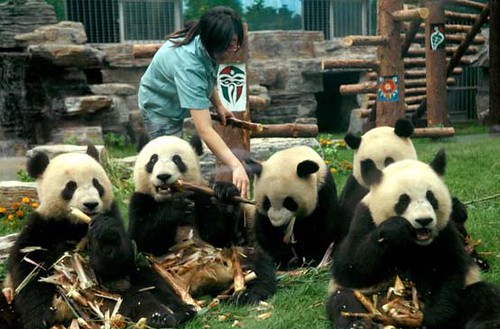tags: giant panda, Ailuropoda melanoleuca, Beijing Zoo, WoLong Panda reserve, mammals, image of the day
A giant panda, Ailuropoda melanoleuca, plays at Beijing Zoo on 2 June 2008 in Beijing, China.
Eight giant pandas were relocated to Beijing zoo, after their WoLong nature reserve was damaged by the earthquake on May 24, 2008. They will spend the next six months at the zoo on a special Olympics visit.
Image: Cai Daizheng (ChinaFotoPress & Getty Images) [larger view].
China's panda keepers are using an unusual method of intervention to help their charges -- eight two-year-old giant pandas -- to cope with the aftermath of the recent earthquake in Sichuan province; lots of hugs, games, gentle talking and plenty of tasty bamboo.
"We talk to the pandas and play with them -- that helps give them psychological support," said Lu Yong, one of the panda's keepers.
The eight pandas usually live in WoLong nature reserve (often known as the WoLong Panda reserve), which is located close to the epicenter of the 24 May temblor. Eight of the animals were recently translocated to the Beijing zoo, just in time for the Olympics games.
Currently, there are 47 more giant pandas still inhabiting the world renowned WoLong nature reserve, despite the fact that it sustained heavy damage. Sadly, the earthquake left one panda keeper hospitalized and killed four more. Additionally, the local natural areas surround the WoLong -- all giant panda habitat -- were also heavily damaged.
"When we saw the rock slides we were really worried," reports Lu, who traveled with his iconic charges to the Beijing zoo's special panda facility.
During and after the earthquake, some WoLong panda keepers rescued baby pandas at great risk to their own lives.
"In a disaster the first thing we think of is the pandas and how to get them to safety. They were very scared and disturbed when the earthquake happened," Lu continues. "They needed support from their keepers before they would eat again."
Tragically, two of the six pandas that escaped during the earthquake are still missing.
"Maybe when the mountain collapsed they could have been buried, but we hope they have escaped into the wild. They have very close ties to the workers and keepers," said Wang Pengyan, the deputy chief of the reserve, who hopefully suggested that the animals might return of their own accord.
Beijing zoo contructed a special panda enclosure for the animals, hoping that foreign visitors attending the Olympics games will be encouraged to donate money to support panda conservation -- and now, to rebuild the seriously damaged WoLong nature reserve. Many of the WoLong reserve's buildings either collapsed or are unsafe, a newly constructed road accessing the center is impassable and vast areas of the surrounding bamboo forest were destroyed by landslides.
The secretary general of the China Wildlife Conservation Association, Yang Baijin, reported that many Sichuan panda reserves had been seriously affected by the quake, which would make preserving the species more difficult. Conservationists estimate that approximately 1,600 pandas currently remain in the wild.
These eight panda "ambassadors" will live at the Beijing zoo for six months before returning to their home at WoLong nature reserve.
A zoo worker feeds giant pandas, Ailuropoda melanoleuca, with bamboo at Beijing Zoo on 2 June 2008 in Beijing, China. Eight giant pandas were relocated to Beijing zoo, after their WoLong nature reserve was damaged by the earthquake on May 24, 2008. They will spend the next six months at the zoo on a special Olympics visit.
Image: Cai Daizheng (ChinaFotoPress & Getty Images) [larger view].
Wang reports that the appetites of the eight translocated pandas have returned to normal. Each animal consumes between 10-18kg (22-40lb) of bamboo each day, along with milk, carrots, apples and steamed buns.
Giant pandas play at the WoLong nature reserve (before the earthquake) [1:20]
Another video of giant pandas playing at the WoLong nature reserve (before the earthquake) -- includes sound [1:06]
Source
The Guardian (quotes).



As everyone knows, there are about 1,590 wild pandas live in China, especially in Sichuan there are 154 captive pandas in Chengdu, Bifengxia and Wolong. And Wolong nature reserve is a very important base for panda. However the earthquake occurred in Sichuan on May 12 let Wolong panda base seriously destroyed. Fortunately no dead body found till now except one. Almost all captive enclosures are collapsed, so most pandas of Wolong now have been transferred to Bifengxia for the security reasons to pandas. If you want to do something such as volunteer for panda bears which is under a dangerous condition, please visit: http://pandatour.com.cn